Ultrasound Study of Magnetic and Non-Magnetic Nanoparticle Agglomeration in High Viscous Media
Abstract
:1. Introduction
2. Materials and Methods
2.1. Preparation of Oil Suspensions of Magnetic and Non-Magnetic Particles
2.2. Experimental Setup
2.3. Calculation of the Ultrasound Attenuation Coefficient Wave Based on FFT Spectra
2.4. Ultrasound Wave Propagation in Two-Phase Systems
3. Results and Discussion
3.1. Ultrasound Spectroscopy for Silica NPs Dispersed in Castor Oil
3.2. Ultrasound Spectroscopy for Magnetite NPs Dispersed in Castor Oil
4. Conclusions
Author Contributions
Funding
Institutional Review Board Statement
Informed Consent Statement
Data Availability Statement
Acknowledgments
Conflicts of Interest
References
- Bruce, I.J.; Sen, T. Surface Modification of Magnetic Nanoparticles with Alkoxysilanes and Their Application in Magnetic Bioseparations. Langmuir 2005, 21, 7029–7035. [Google Scholar] [CrossRef] [PubMed]
- Tishkevich, D.I.; Korolkov, I.V.; Kozlovskiy, A.L.; Anisovich, M.; Vinnik, D.A.; Ermekova, A.E.; Vorobjova, A.I.; Shumskaya, E.E.; Zubar, T.I.; Trukhanov, S.V.; et al. Immobilization of boron-rich compound on Fe3O4 nanoparticles: Stability and cytotoxicity. J. Alloys Compd. 2019, 797, 573–581. [Google Scholar] [CrossRef]
- Roca, A.G.; Gutiérrez, L.; Gavilán, H.; Fortes Brollo, M.E.; Veintemillas-Verdaguer, S.; Morales, M.d.P. Design strategies for shape-controlled magnetic iron oxide nanoparticles. Adv. Drug Deliv. Rev. 2019, 138, 68–104. [Google Scholar] [CrossRef] [PubMed]
- Gavilán, H.; Avugadda, S.K.; Fernández-Cabada, T.; Soni, N.; Cassani, M.; Mai, B.T.; Chantrell, R.; Pellegrino, T. Magnetic nanoparticles and clusters for magnetic hyperthermia: Optimizing their heat performance and developing combinatorial therapies to tackle cancer. Chem. Soc. Rev. 2021, 50, 11614–11667. [Google Scholar] [CrossRef] [PubMed]
- Kaczmarek, K.; Mrówczyński, R.; Hornowski, T.; Bielas, R.; Józefczak, A. The Effect of Tissue-Mimicking Phantom Compressibility on Magnetic Hyperthermia. J. Nanomater. 2019, 9, 803. [Google Scholar] [CrossRef] [Green Version]
- Skumiel, A.; Kopcansky, P.; Timko, M.; Molcan, M.; Paulovicova, K.; Wojciechowski, R. The influence of a rotating magnetic field on the thermal effect in magnetic fluid. Int. J. Therm. Sci. 2022, 171, 107258. [Google Scholar] [CrossRef]
- Smolkova, I.S.; Kazantseva, N.E.; Makoveckaya, K.N.; Smolka, P.; Saha, P.; Granov, A.M. Maghemite based silicone composite for arterial embolization hyperthermia. Mater. Sci. Eng. C Mater. Biol. Appl. 2015, 48, 632–641. [Google Scholar] [CrossRef]
- Leong, S.S.; Ahmad, Z.; Low, S.C.; Camacho, J.; Faraudo, J.; Lim, J. Unified View of Magnetic Nanoparticle Separation under Magnetophoresis. Langmuir 2020, 36, 8033–8055. [Google Scholar] [CrossRef]
- Baresel, C.; Schaller, V.; Jonasson, C.; Johansson, C.; Bordes, R.; Chauhan, V.; Sugunan, A.; Sommertune, J.; Welling, S. Functionalized magnetic particles for water treatment. Heliyon 2019, 5, e02325. [Google Scholar] [CrossRef] [Green Version]
- Fatima, H.; Kim, K.-S. Magnetic nanoparticles for bioseparation. Korean J. Chem. Eng. 2017, 34, 589–599. [Google Scholar] [CrossRef]
- Shokrollahi, H.; Khorramdin, A.; Isapour, G. Magnetic resonance imaging by using nano-magnetic particles. J. Magn. Magn. Mater. 2014, 369, 176–183. [Google Scholar] [CrossRef]
- Jameel, B.; Bielas, R.; Hornowski, T.; Józefczak, A. Propagation of ultrasonic wave in magnetic Pickering emulsion under DC magnetic field. J. Magn. Magn. Mater. 2022, 542, 168590. [Google Scholar] [CrossRef]
- Bielas, R.; Hornowski, T.; Paulovičová, K.; Rajňák, M.; Józefczak, A. The effect of magnetic particles covering the droplets on the heating rate of Pickering emulsions in the AC magnetic field. J. Mol. Liq. 2020, 320, 114388. [Google Scholar] [CrossRef]
- Hossein, F.; Materazzi, M.; Lettieri, P.; Angeli, P. Application of acoustic techniques to fluid-particle systems—A review. Chem. Eng. Res. Des. 2021, 176, 180–193. [Google Scholar] [CrossRef]
- Povey, M.J.W. Ultrasound particle sizing: A review. Particuology 2013, 11, 135–147. [Google Scholar] [CrossRef]
- Cushing, K.W.; Garofalo, F.; Magnusson, C.; Ekblad, L.; Bruus, H.; Laurell, T. Ultrasound Characterization of Microbead and Cell Suspensions by Speed of Sound Measurements of Neutrally Buoyant Samples. Anal. Chem. 2017, 89, 8917–8923. [Google Scholar] [CrossRef]
- Su, Q.; Tan, C.; Dong, F. Measurement of Oil–Water Two-Phase Flow Phase Fraction With Ultrasound Attenuation. IEEE Sens. J. 2018, 18, 1150–1159. [Google Scholar] [CrossRef]
- Silva, C.A.M.; Saraiva, S.V.; Bonetti, D.; Higuti, R.T.; Cunha, R.L.; Pereira, L.O.V.; Silva, F.V.; Fileti, A.M.F. Measurements of bimodal droplet size distribution of emulsions using ultrasonic spectroscopy in the long and intermediate wavelength regimes. Chem. Eng. Sci. 2021, 252, 117274. [Google Scholar] [CrossRef]
- Challis, R.E.; Povey, M.J.W.; Mather, M.L.; Holmes, A.K. Ultrasound techniques for characterizing colloidal dispersions. Rep. Prog. Phys. 2005, 68, 1541–1637. [Google Scholar] [CrossRef]
- Mori, H.; Norisuye, T.; Nakanishi, H.; Tran-Cong-Miyata, Q. Ultrasound attenuation and phase velocity of micrometer-sized particle suspensions with viscous and thermal losses. Ultrasonics 2018, 83, 171–178. [Google Scholar] [CrossRef]
- Hotze, E.M.; Phenrat, T.; Lowry, G.V. Nanoparticle Aggregation: Challenges to Understanding Transport and Reactivity in the Environment. J. Environ. Qual. 2010, 39, 1909–1924. [Google Scholar] [CrossRef] [PubMed] [Green Version]
- Yeap, S.P.; Lim, J.; Ooi, B.S.; Ahmad, A.L. Agglomeration, colloidal stability, and magnetic separation of magnetic nanoparticles: Collective influences on environmental engineering applications. J. Nanopart. Res. 2017, 19, 368. [Google Scholar] [CrossRef]
- Yu, H.; Tan, C.; Dong, F. Particle Size Characterization in Liquid–Solid Dispersion With Aggregates by Broadband Ultrasound Attenuation. IEEE Trans. Instrum. Meas. 2021, 70, 1–11. [Google Scholar] [CrossRef]
- Allouni, Z.E.; Cimpan, M.R.; Høl, P.J.; Skodvin, T.; Gjerdet, N.R. Agglomeration and sedimentation of TiO2 nanoparticles in cell culture medium. Colloids Surf. B 2009, 68, 83–87. [Google Scholar] [CrossRef] [PubMed]
- Greenwood, R.; Lapčíková, B.; Surýnek, M.; Waters, K.; Lapčík, L. The zeta potential of kaolin suspensions measured by electrophoresis and electroacoustics. Chem. Pap. 2007, 61, 83–92. [Google Scholar] [CrossRef]
- Ohiri, K.A.; Evans, B.A.; Shields IV, C.W.; Gutiérrez, R.A.; Carroll, N.J.; Yellen, B.B.; López, G.P. Magnetically Responsive Negative Acoustic Contrast Microparticles for Bioanalytical Applications. ACS Appl. Mater. Interfaces 2016, 8, 25030–25035. [Google Scholar] [CrossRef]
- Diao, J.; Xia, Y.; Jiang, X.; Qiu, J.; Cheng, S.; Su, J.; Duan, X.; Gao, M.; Qin, X.; Zhang, J.; et al. Silicon dioxide nanoparticles induced neurobehavioral impairments by disrupting microbiota-gut-brain axis. J Nanobiotechnol. 2021, 19, 174. [Google Scholar] [CrossRef]
- Challis, R.; Tebbutt, J.; Holmes, A. Equivalence between three scattering formulations for ultrasonic wave propagation in particulate mixtures. J. Phys. D Appl. Phys. 1998, 31, 3481. [Google Scholar] [CrossRef]
- Vinogradov, A. Physicochemical and acoustic properties of water-based magnetic colloid. J. Colloid Sci. 2004, 66, 29–37. [Google Scholar] [CrossRef]
- Kaye, G.W.C.; Laby, T. Tables of Physical and Chemical Constants 16th edn (Harlow); NPL (National Physical Laboratory): Teddington, UK, 1995. [Google Scholar]
- Patel, V.R.; Dumancas, G.G.; Viswanath, L.C.K.; Maples, R.; Subong, B.J.J. Castor oil: Properties, uses, and optimization of processing parameters in commercial production. Lipid Insights 2016, 9, S40233. [Google Scholar] [CrossRef] [Green Version]
- Tong, J.; Povey, M.J.W. Pulse echo comparison method with FSUPER to measure velocity dispersion in n-tetradecane in water emulsions. Ultrasonics 2002, 40, 37–41. [Google Scholar] [CrossRef]
- Holmes, A.K.; Challis, R.E.; Wedlock, D.J. A wide-bandwidth ultrasonic study of suspensions: The variation of velocity and attenuation with particle size. J. Colloid Interface Sci. 1994, 168, 339–348. [Google Scholar] [CrossRef]
- Strohm, E.M.; Kolios, M.C. Sound velocity and attenuation measurements of perfluorocarbon liquids using photoacoustic methods. In Proceedings of the 2011 IEEE International Ultrasonics Symposium, Orlando, FL, USA, 18–21 October 2011; pp. 2368–2371. [Google Scholar]
- Treeby, B.E.; Cox, B.T.; Zhang, E.Z.; Patch, S.K.; Beard, P.C. Measurement of Broadband Temperature-Dependent Ultrasonic Attenuation and Dispersion Using Photoacoustics. IEEE Trans. Ultrason. Ferroelectr. Freq. Control 2009, 56, 1666–1676. [Google Scholar] [CrossRef] [PubMed]
- Epstein, P.S.; Carhart, R.R. The absorption of sound in suspensions and emulsions. I. Water fog in air. J. Acoust. Soc. Am. 1953, 25, 553–565. [Google Scholar] [CrossRef]
- Allegra, J.R.; Hawley, S.A. Attenuation of Sound in Suspensions and Emulsions: Theory and Experiments. J. Acoust. Soc. Am. 1972, 51, 1545–1564. [Google Scholar] [CrossRef]
- Saleh, A.S.; Lee, J.-Y.; Jo, Y.; Yun, J.-I. Uranium(VI) sorption complexes on silica in the presence of calcium and carbonate. J. Environ. Radioact. 2018, 182, 63–69. [Google Scholar] [CrossRef]
- Rajnak, M.; Dolnik, B.; Hodermarsky, P.; Paulovicova, K.; Cimbala, R.; Timko, M.; Kopcansky, P. Dynamic magnetic response of ferrofluids under a static electric field. Phys. Fluids 2021, 33, 082006. [Google Scholar] [CrossRef]
- Kaczmarek, K.; Bielas, R.; Siluk, M.; Hornowski, T.; Józefczak, A. Comparison of magnetic and non-magnetic nanoparticles as sonosensitizers in ultrasonic hyperthermia. Acta Physica Polonica A 2020, 137, 653–656. [Google Scholar] [CrossRef]
- Kaczmarek, K.; Hornowski, T.; Kubovčíková, M.; Timko, M.; Koralewski, M.; Józefczak, A. Heating Induced by Therapeutic Ultrasound in the Presence of Magnetic Nanoparticles. ACS Appl. Mater. Interfaces 2018, 10, 11554–11564. [Google Scholar] [CrossRef]
- Mori, H.; Norisuye, T.; Nakanishi, H.; Tran-Cong-Miyata, Q. Ultrasound attenuation and phase velocity of moderately concentrated silica suspensions. Ultrasonics 2019, 93, 63–70. [Google Scholar] [CrossRef]
- Schwaminger, S.P.; Schwarzenberger, K.; Gatzemeier, J.; Lei, Z.; Eckert, K. Magnetically Induced Aggregation of Iron Oxide Nanoparticles for Carrier Flotation Strategies. J. Environ. Radioact. 2021, 13, 20830–20844. [Google Scholar] [CrossRef] [PubMed]
- Serantes, D.; Baldomir, D. Nanoparticle Size Threshold for Magnetic Agglomeration and Associated Hyperthermia Performance. Nanomaterials 2021, 11, 2786. [Google Scholar] [CrossRef] [PubMed]
- Gambinossi, F.; Mylon, S.E.; Ferri, J.K. Aggregation kinetics and colloidal stability of functionalized nanoparticles. Adv. Colloid Interface Sci. 2015, 222, 332–349. [Google Scholar] [CrossRef] [PubMed]
- Wu, W.; Ichihara, G.; Suzuki, Y.; Izuoka, K.; Oikawa-Tada, S.; Chang, J.; Sakai, K.; Miyazawa, K.; Porter, D.; Castranova, V. Dispersion method for safety research on manufactured nanomaterials. Ind. Health 2014, 52, 54–65. [Google Scholar] [CrossRef] [Green Version]
- Choi, Y.-W.; Lee, H.; Song, Y.; Sohn, D. Colloidal stability of iron oxide nanoparticles with multivalent polymer surfactants. J. Colloid Interface Sci. 2015, 443, 8–12. [Google Scholar] [CrossRef]
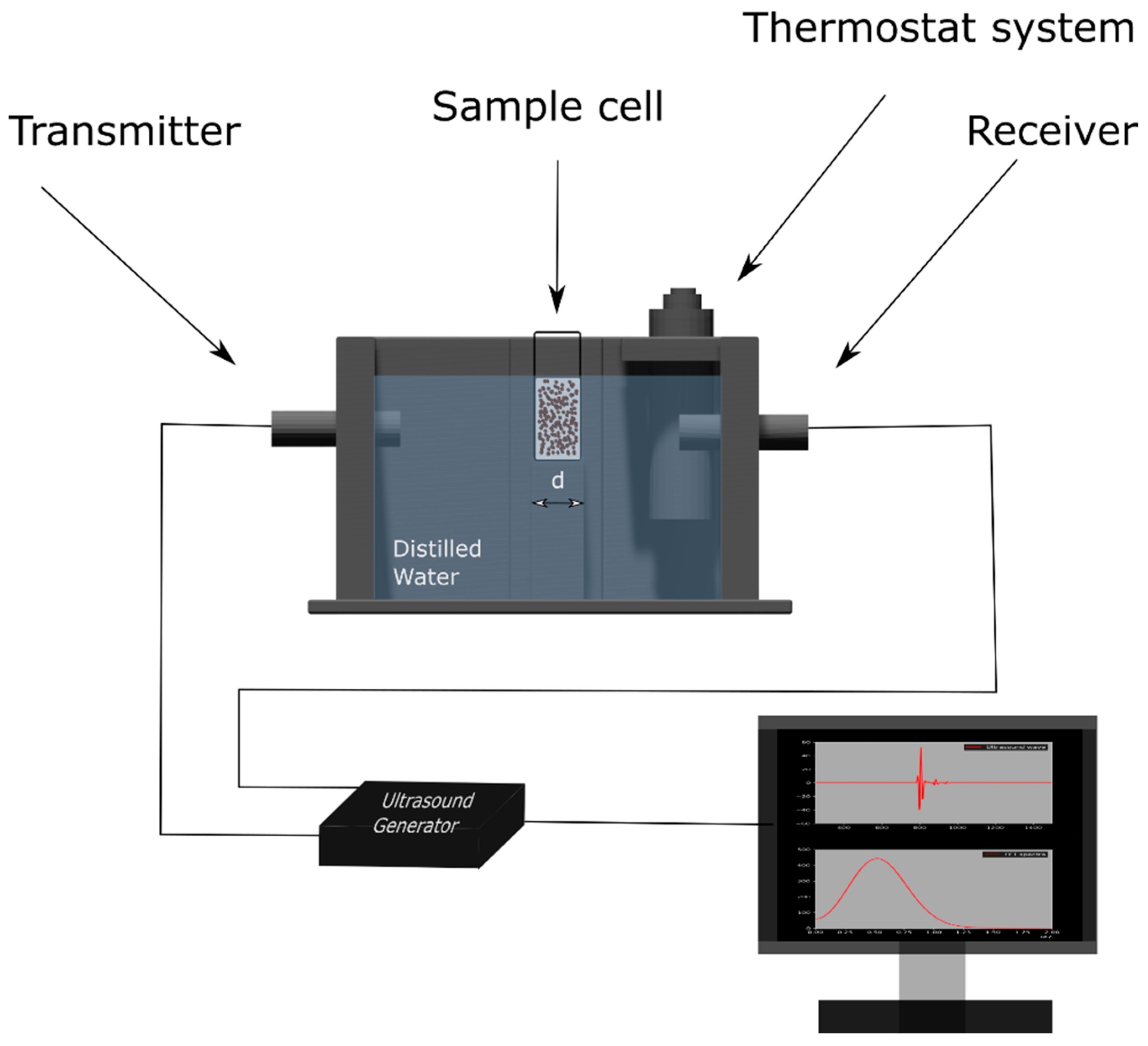
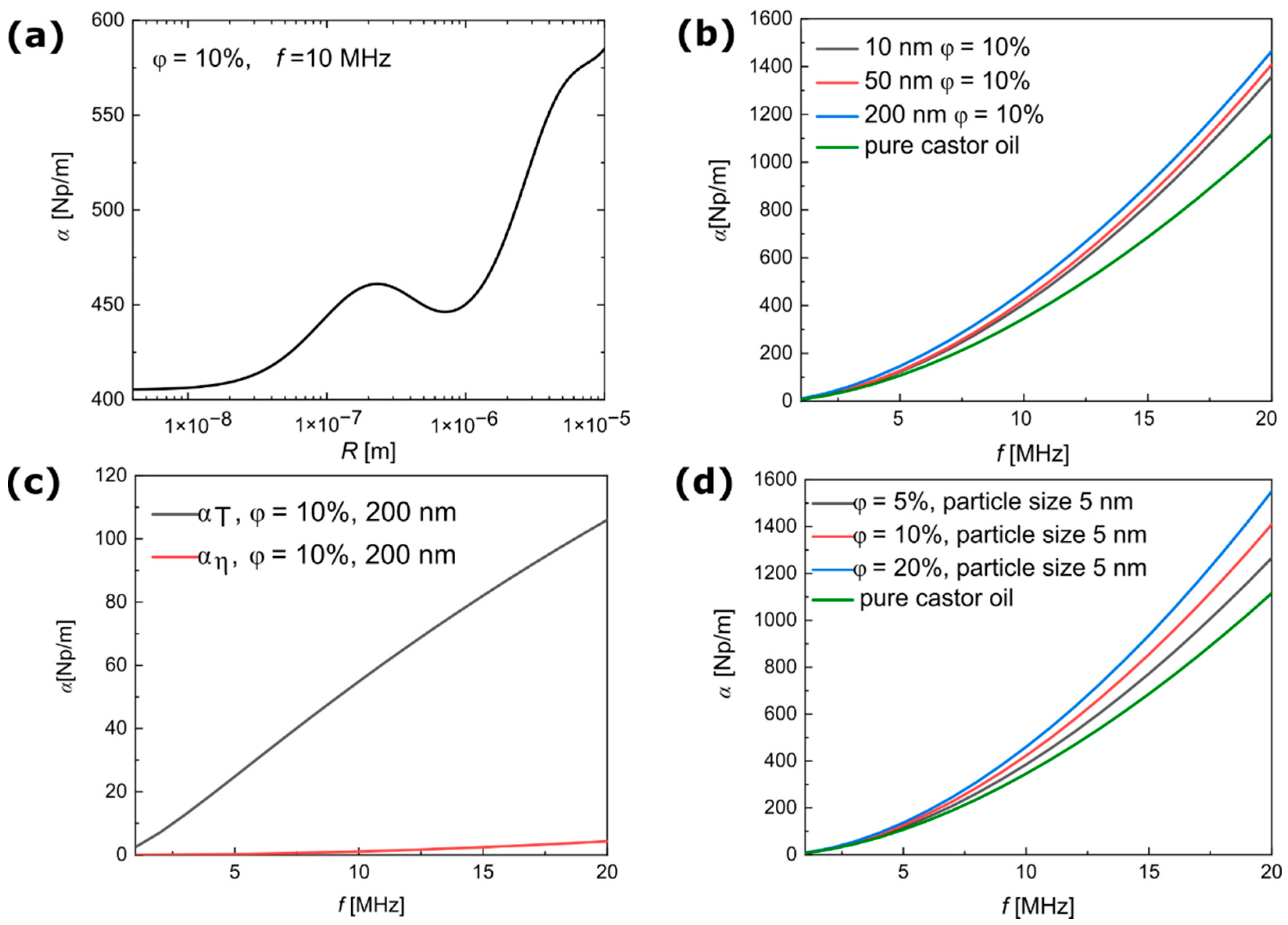
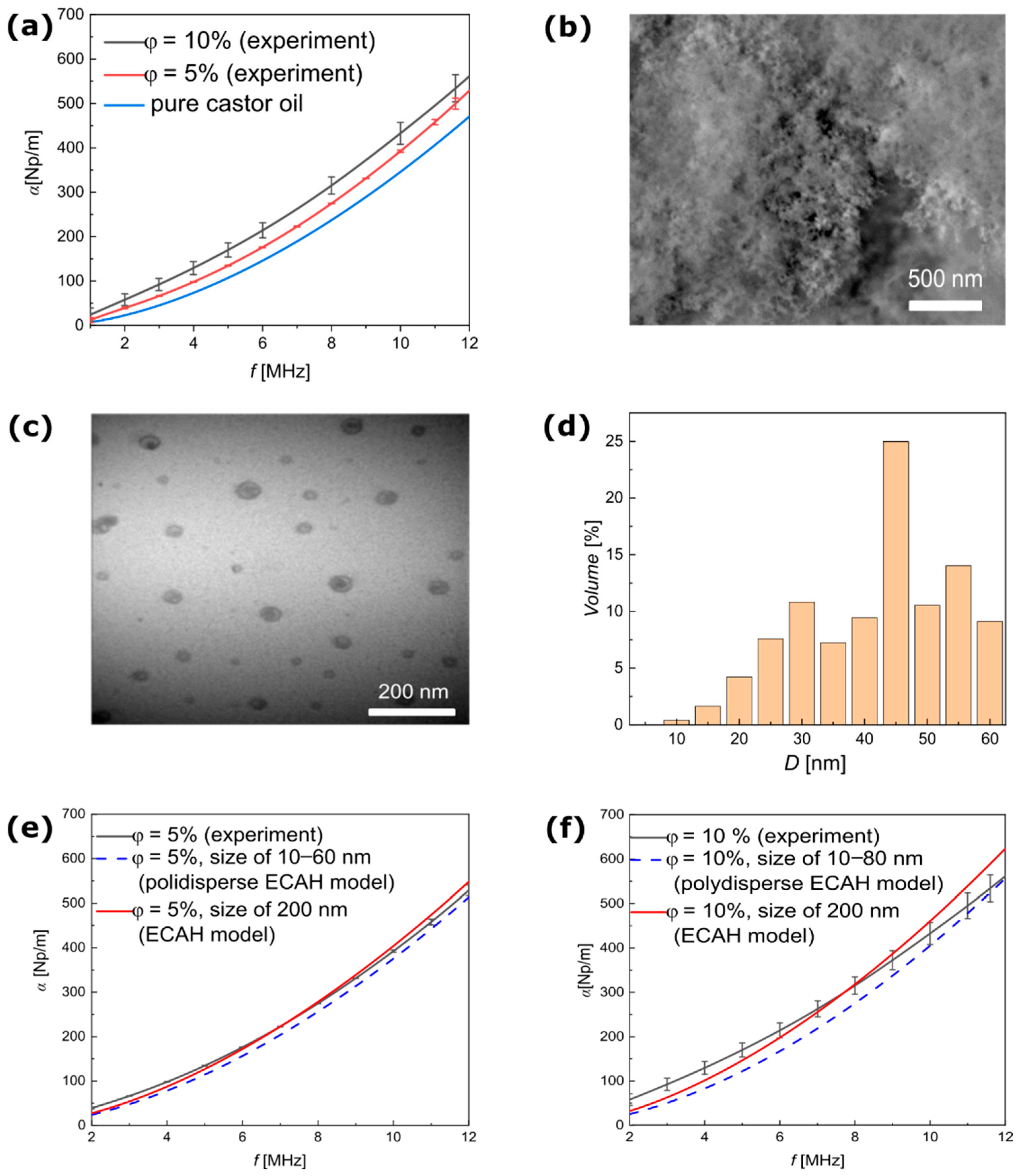

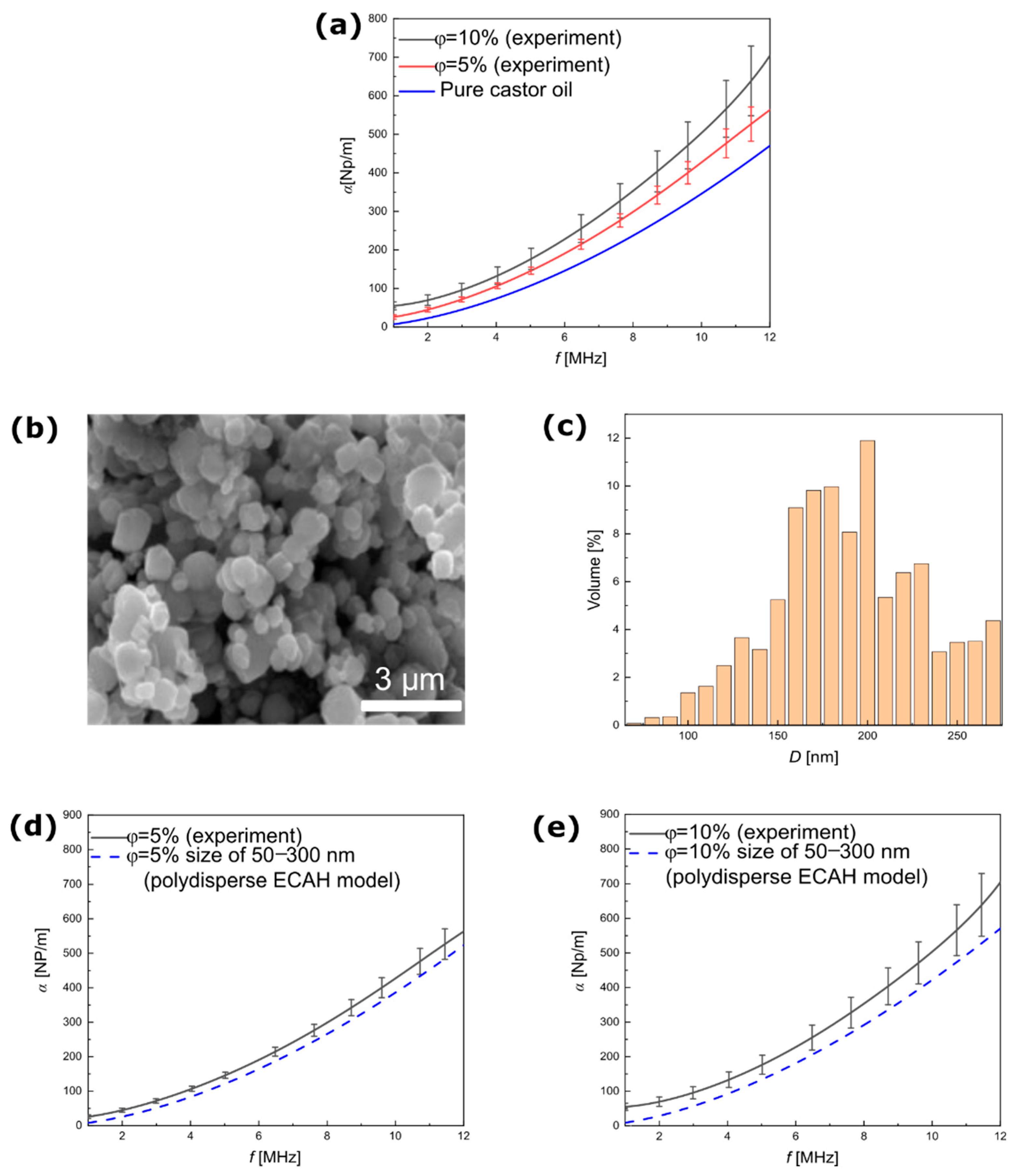
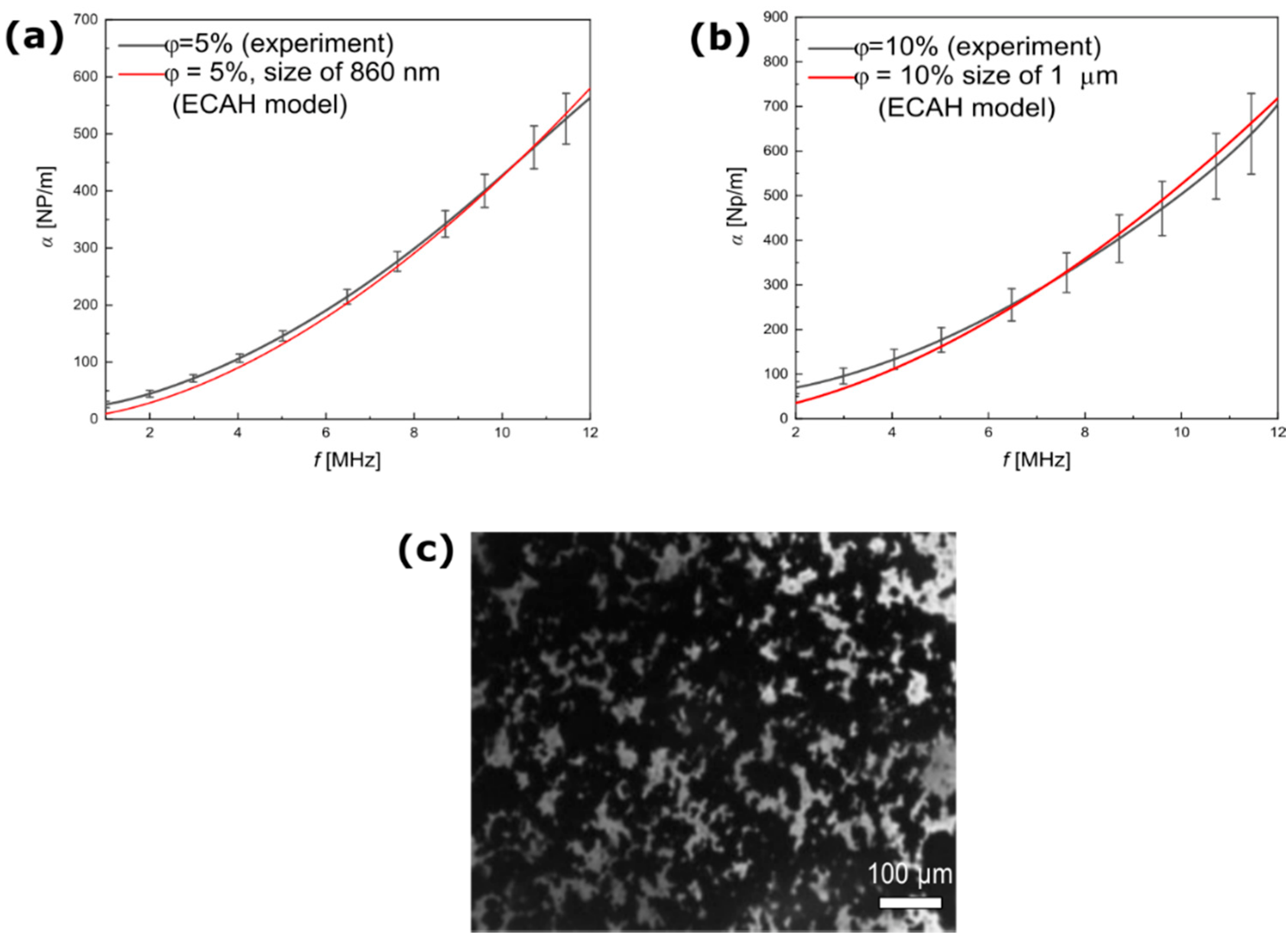
| Parameters | Castor Oil | Silica NPs | Magnetite NPs |
|---|---|---|---|
| − | − | ||
| (kg/) | 957 | 1970 [28] | 5180 [29] |
| 0.180 | 1.6 [30] | 52 [29] | |
| 1800 | 728.5 [30] | 653 [29] | |
| [31] | [30] | [29] | |
| Ultrasound velocity c (m/s) | 1455 | 5968 [30] | 7157 [29] |
| [32] | [33] | [29] | |
| Shear module | − | [30] | [29] |
Publisher’s Note: MDPI stays neutral with regard to jurisdictional claims in published maps and institutional affiliations. |
© 2022 by the authors. Licensee MDPI, Basel, Switzerland. This article is an open access article distributed under the terms and conditions of the Creative Commons Attribution (CC BY) license (https://creativecommons.org/licenses/by/4.0/).
Share and Cite
Jameel, B.; Hornowski, T.; Bielas, R.; Józefczak, A. Ultrasound Study of Magnetic and Non-Magnetic Nanoparticle Agglomeration in High Viscous Media. Materials 2022, 15, 3450. https://doi.org/10.3390/ma15103450
Jameel B, Hornowski T, Bielas R, Józefczak A. Ultrasound Study of Magnetic and Non-Magnetic Nanoparticle Agglomeration in High Viscous Media. Materials. 2022; 15(10):3450. https://doi.org/10.3390/ma15103450
Chicago/Turabian StyleJameel, Bassam, Tomasz Hornowski, Rafał Bielas, and Arkadiusz Józefczak. 2022. "Ultrasound Study of Magnetic and Non-Magnetic Nanoparticle Agglomeration in High Viscous Media" Materials 15, no. 10: 3450. https://doi.org/10.3390/ma15103450
APA StyleJameel, B., Hornowski, T., Bielas, R., & Józefczak, A. (2022). Ultrasound Study of Magnetic and Non-Magnetic Nanoparticle Agglomeration in High Viscous Media. Materials, 15(10), 3450. https://doi.org/10.3390/ma15103450








